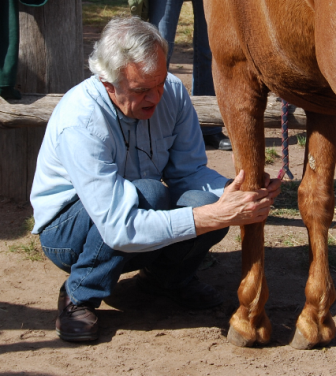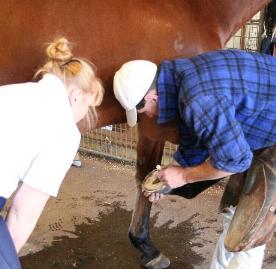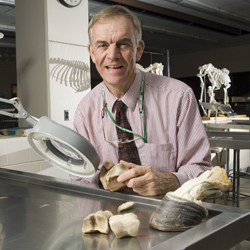| Professor Robert Bowker & the Equine Hoof Laboratory
Professor Bowker heads up the Equine Hoof Laboratory at Michigan State University. His work and his teams work there has thrown new light onto the functions of the hoof and its internal components and their relationship to soundness. His research has lead to a greater understanding of natural hoof care as a powerful rehabilitation tool. This science is backed up by the now thousands of successful rehabilitations for serious hoof problem such as navicular syndrome. He explains that we are living in unusual times and professionals working in hoof care need to "catch up" with those working at the coal face of hoof care.
Have we seen so many unhealthy hooves for so long that we no longer recognise the causes! Its time we fast tracked this information. The Equine Hoof Laboratory at Michigan University is the home of much of the new research into the hoof. From their work we are only now beginning to understand the true nature and biomechanical functions of the hoof and its internal components. Read about their work: Some more interesting studies by Professor Bowker and other leaders in barefoot research: Osteo-poriotic Coffin Bones Contrasting structural morphologies of good footed and bad footed horses. Haemodynamic flow theory Bowker_Lateral_Cartilage_hemodynamics.pdf Wolf's Law of Orthopedics and why it applies to shod horses. Bone_Remodeling_of_the_Equine_Distal_Limb |
Veterinarians - like to know more about ways to achieve a more successful outcomes with rehabilitation?Consider new strategies for serious hoof issues such as navicular syndrome?Professor Robert Bowker visits Australia regularly to lecture to students studying Equine Podiotherapy at the Australian College of Equine Podiotherapy. He also offers seminars whilst he is here featuring his research work. If you are a veterinarian and would like to talk to him about his work he welcomes your interest. Many Australian equine veterinarians are now also Equine Podiotherapists because this type of rehabilitation therapy has allowed them access to new strategies for helping laminitic and navicular horses. www.equinepodiotherapy.com.au
Bio: Professor Robert BowkerEducation and Training: PhD, Neurobiology, University of Pennsylvania, 1979 VMD, Veterinary Medicine, University of Pennsylvania, 1973 BS, Biology/chemistry, Springfield College, 1969
His work has also revealed the relationship between healthy hooves and healthy biomechanics, and how both can become dysfunctional when the hoof is unhealthy or under influences that impact on its ability to be self maintaining. Bob has a deep love for animals and a particular interest in horses and his studies have helped explain many of the amazing changes to the equine hoof that natural hoof care is revealing all around us at the moment. Robert Bowker grew up in northern New England before going to undergraduate school in Massachusetts and then on to veterinary school at the University of Pennsylvania, where he met Barb. Following graduation he continued his studies in neurobiology, receiving his PhD and continuing on at several major universities in the U.S. His research interests in horses began in the early 90's when he began focusing upon understanding how nerves aid and improve foot function, how horses use the many sensations present in the foot to negotiate within its environment and how the foot dissipates energy and supports the horse during health and disease conditions. He has presented his results to numerous international and national audiences over the past ten plus years. He enjoys teaching vets at Michigan University and lecturing for interested groups about the equine foot as he believes that a healthy foot translates to a healthy horse.
Bowker RM, Bowker RM, Bowker RM, Sonea IM, Wilson Bowker RM, Sonea IM, Rosenstein DS, Bowker RM, VanWulfen KK and VanWulfen KK and Bowker, R.M. 2003. The Bowker, R.M. 2003. Bidwell, L.A. and R.M. Bowker. Bowker, R.M. and E.E. Haas. Lancaster L.S., R.M. Bowker |



